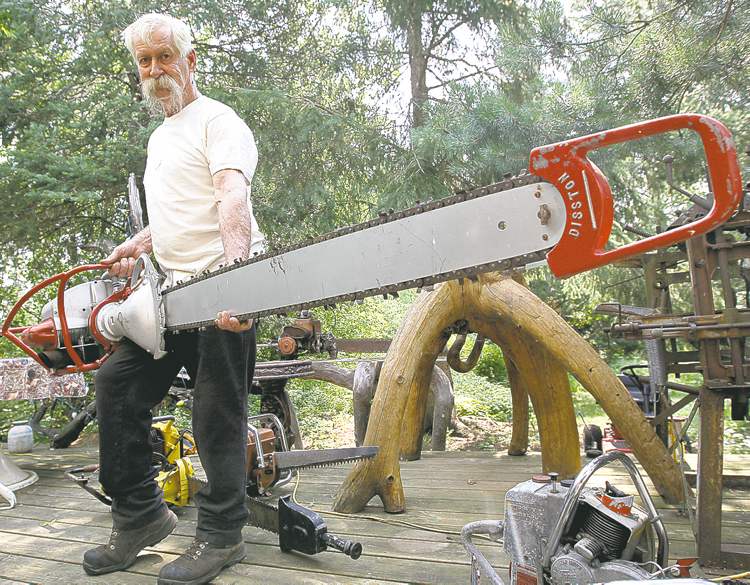Chainsaw fan against provincial-park ban
Advertisement
Read this article for free:
or
Already have an account? Log in here »
To continue reading, please subscribe:
Monthly Digital Subscription
$1 per week for 24 weeks*
- Enjoy unlimited reading on winnipegfreepress.com
- Read the E-Edition, our digital replica newspaper
- Access News Break, our award-winning app
- Play interactive puzzles
*Billed as $4.00 plus GST every four weeks. After 24 weeks, price increases to the regular rate of $19.00 plus GST every four weeks. Offer available to new and qualified returning subscribers only. Cancel any time.
Monthly Digital Subscription
$4.75/week*
- Enjoy unlimited reading on winnipegfreepress.com
- Read the E-Edition, our digital replica newspaper
- Access News Break, our award-winning app
- Play interactive puzzles
*Billed as $19 plus GST every four weeks. Cancel any time.
To continue reading, please subscribe:
Add Free Press access to your Brandon Sun subscription for only an additional
$1 for the first 4 weeks*
*Your next subscription payment will increase by $1.00 and you will be charged $16.99 plus GST for four weeks. After four weeks, your payment will increase to $23.99 plus GST every four weeks.
Read unlimited articles for free today:
or
Already have an account? Log in here »
Hey there, time traveller!
This article was published 20/07/2012 (4845 days ago), so information in it may no longer be current.
RENNIE — The chainsaw may have saved more provincial park forests, cottages, wildlife habitat and lives than the water bomber, to hear logger Lawrence Feilberg tell it.
Loggers use chainsaws to harvest mature trees that otherwise become kindling waiting to turn into forest fires from the first lightning strike.
And if you fly over Whiteshell Provincial Park today, you’ll see the ground mottled with the rusty red of dead spruce and pine trees, the consequence of the province’s ban on logging in provincial parks since 2008, Feilberg says.

“This place is going to burn,” he predicts of the Whiteshell. “There is so much deadwood around. There’s so much fuel.”
That could prove especially dangerous for places such as Big Whiteshell Lake. “Big Whiteshell is at the end of one long driveway (Highway 309). There’s only one way in and one way out.”
Feilberg, who cut down his first tree when he was five years old, argues the NDP government made a political decision when it banned logging of mature trees in its parks.
Harvesting mature trees “is a simulated forest fire,” he says. “It’s a way of renewing the forest.”
Feilberg has been a logger for 40 years. He’s felled more than a million trees in his lifetime. So if he seems a little fond of the old chainsaw, he is. He’s got 200 of them.
The modern chainsaw came out after the Second World War, but they were still beasts at the time. One of Feilberg’s prize chainsaws weighs 54 kilograms. The early chainsaws were two-man operations. There was a grip at the end of the blade for one person to guide the cut, almost like on a Swede saw. Even earlier, chainsaws were so big they had to be wheeled up to a tree.
One of his collector items is a bright-yellow 1946 Hornet, made by the Hornet Chainsaw Co. of Guelph, Ont. It had a 1.2-metre blade and used what is called a “scratch chain,” a chain of little daggers.
Another early chainsaw, a Disston made in Philadelphia, had a hand clutch to shut off the machine in case the blade got pinched in the cut.
“The early chainsaws could kick like a mule. A lot of guys broke wrists,” Feilberg says.
Another chainsaw had a little reservoir over the blade that slowly dripped oil for lubrication. Another antique model had a little knob to adjust the chain’s tension.
By the 1950s, the chainsaw was getting lighter and more powerful, and one person could operate it. One failed invention, called the Red Rebel, used a chain with a reciprocating (back and forth) motion instead of revolving around the bar in one direction. Another failed invention was a chain that slid over the bar. Today, all chains fit into a groove along the bar’s edge.
The chain on the saws is amazing. You’d expect it to be all little daggers, like a handsaw. Instead, the chains are a series of little points and hooks. The chain actually mimics the teeth of the pine beetle, those beetles with the long antennae you often see around aging pine trees, says Feilberg.
He’s got a 1951 Redhead and a 1949 Woodboss. Then there’s the Holiday. “What a name for a chainsaw,” he comments. “They evolved from man-killer names to Holiday.”
Some early makes had exhaust pipes and even a dual exhaust. The McCulloch company came out with an early model that had two starter ropes.
“If a guy’s in the bush and breaks the starter rope, he doesn’t have to go back and fix it,” Feilberg explains.
He has 26 different makes of chainsaw. There were once about 40 manufacturers. Now there are just two: Stihl in Germany and Homelite in Sweden.
bill.redekop@freepress.mb.ca

